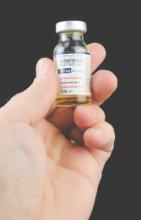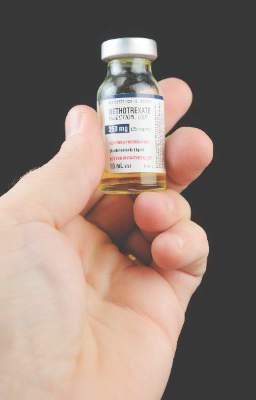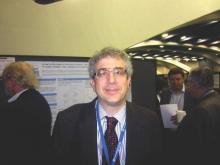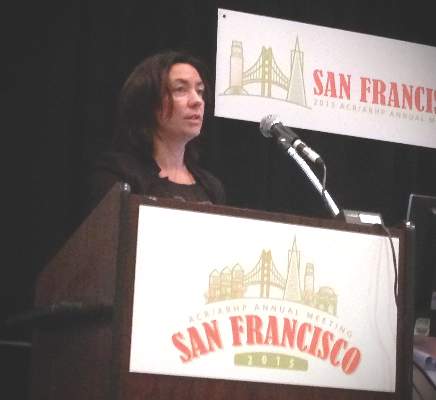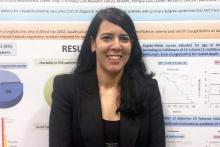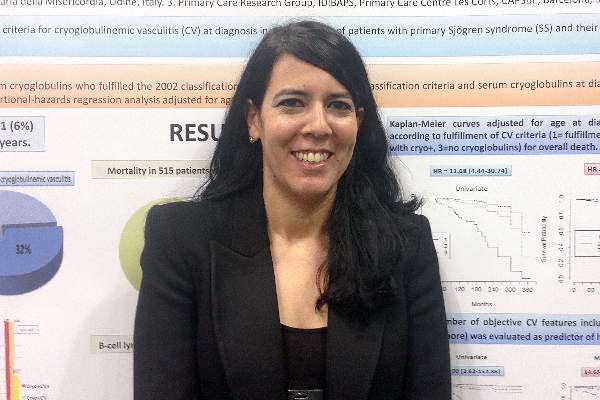User login
American College of Rheumatology (ACR): Annual Scientific Meeting
ACR: Push back when insurance decisions force TNFi change
SAN FRANCISCO – Stopping a tumor necrosis factor inhibitor for nonmedical reasons is associated with significantly worse clinical outcomes and increased health care resource use, according to a review of 166 rheumatoid arthritis patients from the Physicians Consulting Network.
That’s probably not a surprise; the main value of the findings is that they provide ammunition to push back against insurance decisions that lead to stopping or switching tumor necrosis factor inhibitors (TNFi) that are helping patients.
After being stable on their TNFi for at least 6 months, 25 patients in the study were forced to stop their medication for a range of nonmedical economic reasons such as increased copays, change of insurance, or loss of job health insurance. Another 58 switched to a new TNFi for similar reasons. Those 83 patients were matched to 83 others who were also stable on their TNFi for at least 6 months but continued the therapy. Data came from chart reviews by rheumatologists, and all the patients were under the care of physicians participating in the Physicians Consulting Network, which provides feedback to GfK, a market research firm.
Over the next year, 48% of switchers/discontinuers were deemed to have well controlled RA by their rheumatologists, versus 84% of continuers. Switchers and discontinuers were almost 4 times as likely to flare, and more than 10 times as likely to have severe RA at the end of the year.
Switchers/discontinuers also had more inpatient days and emergency department and urgent care visits. Switchers and discontinuers had more than six times greater odds of visiting emergency departments and urgent care clinics at least once, compared with continuers. The differences were statistically significant. In short, payers may have saved on the front end, but probably lost on the back end.
“These real world data demonstrate that patients are significantly affected by switching or discontinuing their stable and effective [TNFi] therapy for rheumatoid arthritis. I don’t think there is any patient who asks to have their [TNFi] switched when they are doing well, and it would be uncommon for a rheumatologist to switch or discontinue [a TNFi] when patients are doing well. These are insurance-driven things that are impacting negatively on patient care, and this should stop. The [American College of Rheumatology] and other groups need to work together to get insurance companies to stop intervening in this way,” said investigator Dr. Douglas Wolf, medical director at Atlanta Gastroenterology Associates.
Similar problems have been reported when TNFi drugs are switched or stopped in Crohn’s disease, psoriasis, and other immunologic conditions, he said at the annual meeting of the American College of Rheumatology.
Switchers and discontinuers were more likely than were continuers to be Hispanic (27.7% vs. 15.7%; P = .041), but otherwise there were no significant differences between cohorts in baseline sociodemographic and disease characteristics, comorbidities, medication use, or resource utilization.
The investigators plan to continue the project to see if TNFi switchers fair better than discontinuers.
Dr. Wolf and other investigators disclosed relationships with AbbVie, including some who received payments from the company to participate in the research. Three authors are employees of AbbVie, maker of adalimumab (Humira).
SAN FRANCISCO – Stopping a tumor necrosis factor inhibitor for nonmedical reasons is associated with significantly worse clinical outcomes and increased health care resource use, according to a review of 166 rheumatoid arthritis patients from the Physicians Consulting Network.
That’s probably not a surprise; the main value of the findings is that they provide ammunition to push back against insurance decisions that lead to stopping or switching tumor necrosis factor inhibitors (TNFi) that are helping patients.
After being stable on their TNFi for at least 6 months, 25 patients in the study were forced to stop their medication for a range of nonmedical economic reasons such as increased copays, change of insurance, or loss of job health insurance. Another 58 switched to a new TNFi for similar reasons. Those 83 patients were matched to 83 others who were also stable on their TNFi for at least 6 months but continued the therapy. Data came from chart reviews by rheumatologists, and all the patients were under the care of physicians participating in the Physicians Consulting Network, which provides feedback to GfK, a market research firm.
Over the next year, 48% of switchers/discontinuers were deemed to have well controlled RA by their rheumatologists, versus 84% of continuers. Switchers and discontinuers were almost 4 times as likely to flare, and more than 10 times as likely to have severe RA at the end of the year.
Switchers/discontinuers also had more inpatient days and emergency department and urgent care visits. Switchers and discontinuers had more than six times greater odds of visiting emergency departments and urgent care clinics at least once, compared with continuers. The differences were statistically significant. In short, payers may have saved on the front end, but probably lost on the back end.
“These real world data demonstrate that patients are significantly affected by switching or discontinuing their stable and effective [TNFi] therapy for rheumatoid arthritis. I don’t think there is any patient who asks to have their [TNFi] switched when they are doing well, and it would be uncommon for a rheumatologist to switch or discontinue [a TNFi] when patients are doing well. These are insurance-driven things that are impacting negatively on patient care, and this should stop. The [American College of Rheumatology] and other groups need to work together to get insurance companies to stop intervening in this way,” said investigator Dr. Douglas Wolf, medical director at Atlanta Gastroenterology Associates.
Similar problems have been reported when TNFi drugs are switched or stopped in Crohn’s disease, psoriasis, and other immunologic conditions, he said at the annual meeting of the American College of Rheumatology.
Switchers and discontinuers were more likely than were continuers to be Hispanic (27.7% vs. 15.7%; P = .041), but otherwise there were no significant differences between cohorts in baseline sociodemographic and disease characteristics, comorbidities, medication use, or resource utilization.
The investigators plan to continue the project to see if TNFi switchers fair better than discontinuers.
Dr. Wolf and other investigators disclosed relationships with AbbVie, including some who received payments from the company to participate in the research. Three authors are employees of AbbVie, maker of adalimumab (Humira).
SAN FRANCISCO – Stopping a tumor necrosis factor inhibitor for nonmedical reasons is associated with significantly worse clinical outcomes and increased health care resource use, according to a review of 166 rheumatoid arthritis patients from the Physicians Consulting Network.
That’s probably not a surprise; the main value of the findings is that they provide ammunition to push back against insurance decisions that lead to stopping or switching tumor necrosis factor inhibitors (TNFi) that are helping patients.
After being stable on their TNFi for at least 6 months, 25 patients in the study were forced to stop their medication for a range of nonmedical economic reasons such as increased copays, change of insurance, or loss of job health insurance. Another 58 switched to a new TNFi for similar reasons. Those 83 patients were matched to 83 others who were also stable on their TNFi for at least 6 months but continued the therapy. Data came from chart reviews by rheumatologists, and all the patients were under the care of physicians participating in the Physicians Consulting Network, which provides feedback to GfK, a market research firm.
Over the next year, 48% of switchers/discontinuers were deemed to have well controlled RA by their rheumatologists, versus 84% of continuers. Switchers and discontinuers were almost 4 times as likely to flare, and more than 10 times as likely to have severe RA at the end of the year.
Switchers/discontinuers also had more inpatient days and emergency department and urgent care visits. Switchers and discontinuers had more than six times greater odds of visiting emergency departments and urgent care clinics at least once, compared with continuers. The differences were statistically significant. In short, payers may have saved on the front end, but probably lost on the back end.
“These real world data demonstrate that patients are significantly affected by switching or discontinuing their stable and effective [TNFi] therapy for rheumatoid arthritis. I don’t think there is any patient who asks to have their [TNFi] switched when they are doing well, and it would be uncommon for a rheumatologist to switch or discontinue [a TNFi] when patients are doing well. These are insurance-driven things that are impacting negatively on patient care, and this should stop. The [American College of Rheumatology] and other groups need to work together to get insurance companies to stop intervening in this way,” said investigator Dr. Douglas Wolf, medical director at Atlanta Gastroenterology Associates.
Similar problems have been reported when TNFi drugs are switched or stopped in Crohn’s disease, psoriasis, and other immunologic conditions, he said at the annual meeting of the American College of Rheumatology.
Switchers and discontinuers were more likely than were continuers to be Hispanic (27.7% vs. 15.7%; P = .041), but otherwise there were no significant differences between cohorts in baseline sociodemographic and disease characteristics, comorbidities, medication use, or resource utilization.
The investigators plan to continue the project to see if TNFi switchers fair better than discontinuers.
Dr. Wolf and other investigators disclosed relationships with AbbVie, including some who received payments from the company to participate in the research. Three authors are employees of AbbVie, maker of adalimumab (Humira).
AT THE ACR ANNUAL MEETING
Key clinical point: The findings provide ammunition to push back against insurance decisions that lead to stopping or switching tumor necrosis factor inhibitors (TNFi) that are helping patients.
Major finding: After a year of follow-up, 48% of switchers/discontinuers were deemed to have well controlled RA by their rheumatologists, versus 84% of continuers. Switchers and discontinuers were almost 4 times as likely to flare, and more than 10 times as likely to have severe RA at the end of the year.
Data source: Chart review of 166 RA patients.
Disclosures: The investigators disclosed relationships with AbbVie, including payments from the company to participate in the research. Three authors are employed by AbbVie, maker of adalimumab (Humira).
ACR: First U.S. clinical practice guidelines arise for Sjögren’s syndrome management
SAN FRANCISCO – Rituximab is, for now, the first-line option for Sjögren’s syndrome patients with systemic symptoms severe enough to require biologic therapy, according to new systemic treatment guidelines from the Sjögren’s Syndrome Foundation.
In general, tumor necrosis factor inhibitors are out because of the risk of lymphoma; Sjögren’s patients are already at risk for the disease.
The foundation has also released guidelines for the management of dry eyes and prevention of cavities in Sjögren’s. Thirteen more guidelines are in the works to tackle neurologic complications, lung disease, lymphoma, and other issues. The ocular guidelines have been published; the systemic and cavity ones will be soon.
“We are really excited about this. These are the first U.S. clinical practice guidelines for Sjögren’s. It will be a game changer,” said Katherine Hammitt, the Sjögren’s Syndrome Foundation’s vice president of medical and scientific affairs.
Topical fluoride should be used in all patients with dry mouth to prevent cavities, along with measures or medications to increase saliva. A comprehensive corneal exam is the first step for dry eyes to determine if they’re due to a lack of tears or abnormal oil secretion by eyelid glands, which causes tears to evaporate too soon. Treatment proceeds according to the findings.
The recommendations are based on a literature review and the consensus of about 100 Sjögren’s experts. The guidelines address what the experts considered to be the most pressing problems.
The foundation launched the efforts after fielding calls from patients reporting that doctors didn’t understand the disease; didn’t take it seriously; or said there was nothing that could be done. On the flip side, physicians were calling in about problem patients.
“So about 5 years ago, we launched an initiative to address the issues.” With current options, “to tell patients that they don’t need treatment or that nothing can be done is, in my view as a rheumatologist, malpractice,” said presenting author Dr. Frederick Vivino, chief of rheumatology at Penn Presbyterian Medical Center, a University of Pennsylvania teaching hospital in Philadelphia. He is also director of the Penn Sjögren’s Syndrome Center.
Rituximab (Rituxan) isn’t approved for Sjögren’s, but “clinicians are using it quite frequently because it’s really the only [biologic] out there” for the disease. “We’ve seen moderate improvement” of organ involvement, vasculitis, neuropathy, and other extraglandular problems, but “it hasn’t knocked our socks off. We need something better than rituximab” for the sickest patients, Ms. Hammitt said at the annual meeting of the American College of Rheumatology. The guidelines recommend hydroxychloroquine as the first step for inflammatory musculoskeletal pain, followed, as needed, by methotrexate, steroids, and other options. Azathioprine is a good option for recalcitrant musculoskeletal pain, as well as organ involvement. Meanwhile, aerobic exercise is important to help with fatigue.
A baseline corneal exam is “the most important recommendation” for eye patients, Dr. Vivino said.
A stepwise treatment algorithm based on the nature and severity of the problem comes next, and can included tear supplementation and stabilization; control of inflammation of the lacrimal glands and ocular surface; systemic therapy with secretagogues; tear preservation measures; and eyelid surgery. Salivary deficiency causes cavities in Sjögren’s. “If the patient has dry mouth, they need to be given topical fluoride. Either encourage them to ask their dentist, or, as I would do, just prescribe it, and they should use it on a regular basis. The group also felt that giving medications to stimulate saliva flow,” like pilocarpine or cevimeline, “would likely help prevent caries, as well,” Dr. Vivino said.
Sugar-free lozenges or chewing gum can also help with saliva flow. The group gave a weak recommendation for chlorhexidine varnishes, gels, and rinses, and a moderate one for nonfluoride remineralizing agents.
The work was supported by the Sjögren’s Syndrome Foundation, with no pharmaceutical industry funding. Some of the authors have financial ties to numerous pharmaceutical companies.
SAN FRANCISCO – Rituximab is, for now, the first-line option for Sjögren’s syndrome patients with systemic symptoms severe enough to require biologic therapy, according to new systemic treatment guidelines from the Sjögren’s Syndrome Foundation.
In general, tumor necrosis factor inhibitors are out because of the risk of lymphoma; Sjögren’s patients are already at risk for the disease.
The foundation has also released guidelines for the management of dry eyes and prevention of cavities in Sjögren’s. Thirteen more guidelines are in the works to tackle neurologic complications, lung disease, lymphoma, and other issues. The ocular guidelines have been published; the systemic and cavity ones will be soon.
“We are really excited about this. These are the first U.S. clinical practice guidelines for Sjögren’s. It will be a game changer,” said Katherine Hammitt, the Sjögren’s Syndrome Foundation’s vice president of medical and scientific affairs.
Topical fluoride should be used in all patients with dry mouth to prevent cavities, along with measures or medications to increase saliva. A comprehensive corneal exam is the first step for dry eyes to determine if they’re due to a lack of tears or abnormal oil secretion by eyelid glands, which causes tears to evaporate too soon. Treatment proceeds according to the findings.
The recommendations are based on a literature review and the consensus of about 100 Sjögren’s experts. The guidelines address what the experts considered to be the most pressing problems.
The foundation launched the efforts after fielding calls from patients reporting that doctors didn’t understand the disease; didn’t take it seriously; or said there was nothing that could be done. On the flip side, physicians were calling in about problem patients.
“So about 5 years ago, we launched an initiative to address the issues.” With current options, “to tell patients that they don’t need treatment or that nothing can be done is, in my view as a rheumatologist, malpractice,” said presenting author Dr. Frederick Vivino, chief of rheumatology at Penn Presbyterian Medical Center, a University of Pennsylvania teaching hospital in Philadelphia. He is also director of the Penn Sjögren’s Syndrome Center.
Rituximab (Rituxan) isn’t approved for Sjögren’s, but “clinicians are using it quite frequently because it’s really the only [biologic] out there” for the disease. “We’ve seen moderate improvement” of organ involvement, vasculitis, neuropathy, and other extraglandular problems, but “it hasn’t knocked our socks off. We need something better than rituximab” for the sickest patients, Ms. Hammitt said at the annual meeting of the American College of Rheumatology. The guidelines recommend hydroxychloroquine as the first step for inflammatory musculoskeletal pain, followed, as needed, by methotrexate, steroids, and other options. Azathioprine is a good option for recalcitrant musculoskeletal pain, as well as organ involvement. Meanwhile, aerobic exercise is important to help with fatigue.
A baseline corneal exam is “the most important recommendation” for eye patients, Dr. Vivino said.
A stepwise treatment algorithm based on the nature and severity of the problem comes next, and can included tear supplementation and stabilization; control of inflammation of the lacrimal glands and ocular surface; systemic therapy with secretagogues; tear preservation measures; and eyelid surgery. Salivary deficiency causes cavities in Sjögren’s. “If the patient has dry mouth, they need to be given topical fluoride. Either encourage them to ask their dentist, or, as I would do, just prescribe it, and they should use it on a regular basis. The group also felt that giving medications to stimulate saliva flow,” like pilocarpine or cevimeline, “would likely help prevent caries, as well,” Dr. Vivino said.
Sugar-free lozenges or chewing gum can also help with saliva flow. The group gave a weak recommendation for chlorhexidine varnishes, gels, and rinses, and a moderate one for nonfluoride remineralizing agents.
The work was supported by the Sjögren’s Syndrome Foundation, with no pharmaceutical industry funding. Some of the authors have financial ties to numerous pharmaceutical companies.
SAN FRANCISCO – Rituximab is, for now, the first-line option for Sjögren’s syndrome patients with systemic symptoms severe enough to require biologic therapy, according to new systemic treatment guidelines from the Sjögren’s Syndrome Foundation.
In general, tumor necrosis factor inhibitors are out because of the risk of lymphoma; Sjögren’s patients are already at risk for the disease.
The foundation has also released guidelines for the management of dry eyes and prevention of cavities in Sjögren’s. Thirteen more guidelines are in the works to tackle neurologic complications, lung disease, lymphoma, and other issues. The ocular guidelines have been published; the systemic and cavity ones will be soon.
“We are really excited about this. These are the first U.S. clinical practice guidelines for Sjögren’s. It will be a game changer,” said Katherine Hammitt, the Sjögren’s Syndrome Foundation’s vice president of medical and scientific affairs.
Topical fluoride should be used in all patients with dry mouth to prevent cavities, along with measures or medications to increase saliva. A comprehensive corneal exam is the first step for dry eyes to determine if they’re due to a lack of tears or abnormal oil secretion by eyelid glands, which causes tears to evaporate too soon. Treatment proceeds according to the findings.
The recommendations are based on a literature review and the consensus of about 100 Sjögren’s experts. The guidelines address what the experts considered to be the most pressing problems.
The foundation launched the efforts after fielding calls from patients reporting that doctors didn’t understand the disease; didn’t take it seriously; or said there was nothing that could be done. On the flip side, physicians were calling in about problem patients.
“So about 5 years ago, we launched an initiative to address the issues.” With current options, “to tell patients that they don’t need treatment or that nothing can be done is, in my view as a rheumatologist, malpractice,” said presenting author Dr. Frederick Vivino, chief of rheumatology at Penn Presbyterian Medical Center, a University of Pennsylvania teaching hospital in Philadelphia. He is also director of the Penn Sjögren’s Syndrome Center.
Rituximab (Rituxan) isn’t approved for Sjögren’s, but “clinicians are using it quite frequently because it’s really the only [biologic] out there” for the disease. “We’ve seen moderate improvement” of organ involvement, vasculitis, neuropathy, and other extraglandular problems, but “it hasn’t knocked our socks off. We need something better than rituximab” for the sickest patients, Ms. Hammitt said at the annual meeting of the American College of Rheumatology. The guidelines recommend hydroxychloroquine as the first step for inflammatory musculoskeletal pain, followed, as needed, by methotrexate, steroids, and other options. Azathioprine is a good option for recalcitrant musculoskeletal pain, as well as organ involvement. Meanwhile, aerobic exercise is important to help with fatigue.
A baseline corneal exam is “the most important recommendation” for eye patients, Dr. Vivino said.
A stepwise treatment algorithm based on the nature and severity of the problem comes next, and can included tear supplementation and stabilization; control of inflammation of the lacrimal glands and ocular surface; systemic therapy with secretagogues; tear preservation measures; and eyelid surgery. Salivary deficiency causes cavities in Sjögren’s. “If the patient has dry mouth, they need to be given topical fluoride. Either encourage them to ask their dentist, or, as I would do, just prescribe it, and they should use it on a regular basis. The group also felt that giving medications to stimulate saliva flow,” like pilocarpine or cevimeline, “would likely help prevent caries, as well,” Dr. Vivino said.
Sugar-free lozenges or chewing gum can also help with saliva flow. The group gave a weak recommendation for chlorhexidine varnishes, gels, and rinses, and a moderate one for nonfluoride remineralizing agents.
The work was supported by the Sjögren’s Syndrome Foundation, with no pharmaceutical industry funding. Some of the authors have financial ties to numerous pharmaceutical companies.
AT THE ACR ANNUAL MEETING
ACR: Sulfasalazine reduces TNFi antibodies but more poorly than methotrexate
SAN FRANCISCO – Sulfasalazine prevents formation of antibodies against tumor necrosis factor inhibitors, but probably not as well as methotrexate, according to a European study of 140 axial spondyloarthritis patients.
“The effect of sulfasalazine on the development of antidrug antibodies has not been studied before. Our initial hypothesis was that methotrexate would [reduce] antibody formation” because it’s been shown to do that before, but that “sulfasalazine would not. This was a surprise to us,” said senior investigator Dr. Alejandro Balsa, chief of rheumatology at La Paz University Hospital in Madrid.
The findings suggest that sulfasalazine, like methotrexate, might “prevent immunogenicity and, hence ... secondary failure of” a tumor necrosis factor inhibitor (TNFi), he said at the annual meeting of the American College of Rheumatology.
Thirty-one patients (22%) were on infliximab (Remicade) and 109 (78%) were on adalimumab (Humira) in the year-long study, which was conducted in Madrid and Amsterdam.
Of the 90 patients on TNFi monotherapy, 33 (37%) developed TNFi antibodies, including 3 of 13 (23%) on infliximab monotherapy and 30 of 77 (39%) on adalimumab alone. The difference was not statistically significant.
Of the 50 patients on concomitant therapy, antibodies against anti-TNF agents occurred in 6 of 35 on sulfasalazine (17%), including three cases on infliximab and three on adalimumab. There was just one antibody case in 15 patients on methotrexate (7%); the patient was on adalimumab.
The trend toward better antibody protection with methotrexate was, again, not significant, probably because of the small numbers in the study.
Methotrexate and sulfasalazine are not routinely prescribed for axial spondyloarthritis; patients were on them in the study to help with peripheral manifestations. The drugs only prevent antibodies if started before a TNFi. “Once patients develop anti-[TNF] antibodies,” it’s too late, Dr. Balsa noted.
Despite the promising results, he said there’s not enough data at this point to recommend routine pretreatment with methotrexate or sulfasalazine to prevent TNFi antibodies.
As expected, antibodies diminished the clinical effect of a TNFi. Less than a quarter of antibody patients, versus more than a half free from antibodies, reached the investigators’ mark for low disease activity at 1 year: clinical improvement plus a Bath Ankylosing Spondylitis Disease Activity Index (BASDAI) score below 4 and normal C-reactive protein (P = .03).
Also at 1 year, patients on monotherapy had an overall BASDAI improvement of about 1 point on the 10-point scale. Patients on methotrexate gained an additional point or so (P = .04), while those on sulfasalazine gained about a half point extra (P = .16).
“We only saw significant improvements in patients treated with methotrexate, probably because 100% cotreated with methotrexate had free” serum TNFi “at 1 year, as compared with only 82% cotreated with sulfasalazine,” Dr. Balsa said.
Oddly, the investigators detected free serum TNFi at 1 year in 78 (87%) monotherapy patients, which was more than in those cotreated with sulfasalazine; he didn’t address the finding.
The mean BASDAI at baseline was 6. Ankylosing spondylitis was the most common diagnosis in the study. More than half the subjects were men, the majority of patients were HLA-B27 positive, and their mean disease duration was 11 years.
Dr. Balsa’s institution receives research funding from Pfizer, UCB, and Roche, and he receives speakers fees from those companies plus AbbVie, Merck, and Bristol-Myers Squibb. Other investigators disclosed financial ties to those or other companies.
SAN FRANCISCO – Sulfasalazine prevents formation of antibodies against tumor necrosis factor inhibitors, but probably not as well as methotrexate, according to a European study of 140 axial spondyloarthritis patients.
“The effect of sulfasalazine on the development of antidrug antibodies has not been studied before. Our initial hypothesis was that methotrexate would [reduce] antibody formation” because it’s been shown to do that before, but that “sulfasalazine would not. This was a surprise to us,” said senior investigator Dr. Alejandro Balsa, chief of rheumatology at La Paz University Hospital in Madrid.
The findings suggest that sulfasalazine, like methotrexate, might “prevent immunogenicity and, hence ... secondary failure of” a tumor necrosis factor inhibitor (TNFi), he said at the annual meeting of the American College of Rheumatology.
Thirty-one patients (22%) were on infliximab (Remicade) and 109 (78%) were on adalimumab (Humira) in the year-long study, which was conducted in Madrid and Amsterdam.
Of the 90 patients on TNFi monotherapy, 33 (37%) developed TNFi antibodies, including 3 of 13 (23%) on infliximab monotherapy and 30 of 77 (39%) on adalimumab alone. The difference was not statistically significant.
Of the 50 patients on concomitant therapy, antibodies against anti-TNF agents occurred in 6 of 35 on sulfasalazine (17%), including three cases on infliximab and three on adalimumab. There was just one antibody case in 15 patients on methotrexate (7%); the patient was on adalimumab.
The trend toward better antibody protection with methotrexate was, again, not significant, probably because of the small numbers in the study.
Methotrexate and sulfasalazine are not routinely prescribed for axial spondyloarthritis; patients were on them in the study to help with peripheral manifestations. The drugs only prevent antibodies if started before a TNFi. “Once patients develop anti-[TNF] antibodies,” it’s too late, Dr. Balsa noted.
Despite the promising results, he said there’s not enough data at this point to recommend routine pretreatment with methotrexate or sulfasalazine to prevent TNFi antibodies.
As expected, antibodies diminished the clinical effect of a TNFi. Less than a quarter of antibody patients, versus more than a half free from antibodies, reached the investigators’ mark for low disease activity at 1 year: clinical improvement plus a Bath Ankylosing Spondylitis Disease Activity Index (BASDAI) score below 4 and normal C-reactive protein (P = .03).
Also at 1 year, patients on monotherapy had an overall BASDAI improvement of about 1 point on the 10-point scale. Patients on methotrexate gained an additional point or so (P = .04), while those on sulfasalazine gained about a half point extra (P = .16).
“We only saw significant improvements in patients treated with methotrexate, probably because 100% cotreated with methotrexate had free” serum TNFi “at 1 year, as compared with only 82% cotreated with sulfasalazine,” Dr. Balsa said.
Oddly, the investigators detected free serum TNFi at 1 year in 78 (87%) monotherapy patients, which was more than in those cotreated with sulfasalazine; he didn’t address the finding.
The mean BASDAI at baseline was 6. Ankylosing spondylitis was the most common diagnosis in the study. More than half the subjects were men, the majority of patients were HLA-B27 positive, and their mean disease duration was 11 years.
Dr. Balsa’s institution receives research funding from Pfizer, UCB, and Roche, and he receives speakers fees from those companies plus AbbVie, Merck, and Bristol-Myers Squibb. Other investigators disclosed financial ties to those or other companies.
SAN FRANCISCO – Sulfasalazine prevents formation of antibodies against tumor necrosis factor inhibitors, but probably not as well as methotrexate, according to a European study of 140 axial spondyloarthritis patients.
“The effect of sulfasalazine on the development of antidrug antibodies has not been studied before. Our initial hypothesis was that methotrexate would [reduce] antibody formation” because it’s been shown to do that before, but that “sulfasalazine would not. This was a surprise to us,” said senior investigator Dr. Alejandro Balsa, chief of rheumatology at La Paz University Hospital in Madrid.
The findings suggest that sulfasalazine, like methotrexate, might “prevent immunogenicity and, hence ... secondary failure of” a tumor necrosis factor inhibitor (TNFi), he said at the annual meeting of the American College of Rheumatology.
Thirty-one patients (22%) were on infliximab (Remicade) and 109 (78%) were on adalimumab (Humira) in the year-long study, which was conducted in Madrid and Amsterdam.
Of the 90 patients on TNFi monotherapy, 33 (37%) developed TNFi antibodies, including 3 of 13 (23%) on infliximab monotherapy and 30 of 77 (39%) on adalimumab alone. The difference was not statistically significant.
Of the 50 patients on concomitant therapy, antibodies against anti-TNF agents occurred in 6 of 35 on sulfasalazine (17%), including three cases on infliximab and three on adalimumab. There was just one antibody case in 15 patients on methotrexate (7%); the patient was on adalimumab.
The trend toward better antibody protection with methotrexate was, again, not significant, probably because of the small numbers in the study.
Methotrexate and sulfasalazine are not routinely prescribed for axial spondyloarthritis; patients were on them in the study to help with peripheral manifestations. The drugs only prevent antibodies if started before a TNFi. “Once patients develop anti-[TNF] antibodies,” it’s too late, Dr. Balsa noted.
Despite the promising results, he said there’s not enough data at this point to recommend routine pretreatment with methotrexate or sulfasalazine to prevent TNFi antibodies.
As expected, antibodies diminished the clinical effect of a TNFi. Less than a quarter of antibody patients, versus more than a half free from antibodies, reached the investigators’ mark for low disease activity at 1 year: clinical improvement plus a Bath Ankylosing Spondylitis Disease Activity Index (BASDAI) score below 4 and normal C-reactive protein (P = .03).
Also at 1 year, patients on monotherapy had an overall BASDAI improvement of about 1 point on the 10-point scale. Patients on methotrexate gained an additional point or so (P = .04), while those on sulfasalazine gained about a half point extra (P = .16).
“We only saw significant improvements in patients treated with methotrexate, probably because 100% cotreated with methotrexate had free” serum TNFi “at 1 year, as compared with only 82% cotreated with sulfasalazine,” Dr. Balsa said.
Oddly, the investigators detected free serum TNFi at 1 year in 78 (87%) monotherapy patients, which was more than in those cotreated with sulfasalazine; he didn’t address the finding.
The mean BASDAI at baseline was 6. Ankylosing spondylitis was the most common diagnosis in the study. More than half the subjects were men, the majority of patients were HLA-B27 positive, and their mean disease duration was 11 years.
Dr. Balsa’s institution receives research funding from Pfizer, UCB, and Roche, and he receives speakers fees from those companies plus AbbVie, Merck, and Bristol-Myers Squibb. Other investigators disclosed financial ties to those or other companies.
AT THE ACR ANNUAL MEETING
Key clinical point: Pretreatment with sulfasalazine seems to prevent TNFi antibodies, but not as well as methotrexate.
Major finding: Antibodies against anti-TNF agents occurred in 6 of 35 on sulfasalazine (17%), including 3 cases on infliximab and 3 on adalimumab. There was just one antibody case in 15 patients on methotrexate (7%); the patient was on adalimumab.
Data source: European study of 140 axial spondyloarthritis patients
Disclosures: The senior investigator’s institution receives research funding from Pfizer, UCB, and Roche, and he receives speakers fees from those companies plus AbbVie, Merck, and Bristol-Myers Squibb. Other investigators disclosed financial ties to those or other companies.
ACR: The pain of inflammatory disease goes beyond the physical
SAN FRANCISCO – The most common fear of rheumatoid arthritis (RA) and axial spondyloarthritis (axSpA) patients is that their future suffering will be as bad as their past suffering, according to a French survey of 474 patients.
Overall, 182 of the 303 RA patients (60%) and 122 of the 171 axSpA patients (71%) in the study ranked that fear as at least a 7 on a 10-point scale, and it remained a serious and common concern even among the roughly half of patients who were in remission.
Majorities in both groups were highly concerned about deformity, wheel chair dependence, burdening loved ones, losing autonomy, and disease spread to other joints. Less common fears, but still ranked at least a 7 by about one-third to well over half of patients, were more frequent flares, inability to care for others, losing friends, loss of treatment effectiveness, fear of treatment side effects, and not finding help if independence is lost.
In general, axSpA was perceived as the more frightening disease, with patients more likely than those with RA to give fears presented on the survey a score of 7 or higher; axSpA patients also were more likely to fear the impact of disease on pregnancy and work, and more worried about passing disease onto their children. Fears about joints seizing up, bone and spine fusion, and increased flare activity were far more prevalent in the axSpA group.
The findings are from a test run of a new questionnaire being developed in France to capture the psychological burden of chronic inflammatory disease. The idea is to make patients’ fears and convictions explicit so that providers know what they are and can help patients cope.
“We’ve had this idea for a long time. Patients have fears and beliefs that” are difficult to express, and they get in the way of effective office communication. The questionnaire might break down the walls, so “patients know their doctors understand and are concerned” about their overall well-being, said senior investigator Dr. Francis Berenbaum, chief of rheumatology at Saint Antoine Hospital in Paris.
It’s hoped that the efforts will improve trust and dialogue between patients and doctors and lead to better treatment adherence and follow-up, more effective counseling, and perhaps even new patient-related outcomes for clinical trials, he said at the annual meeting of the American College of Rheumatology.
To create the survey, the team conducted semi-structured patient interviews at rheumatology practices across France. They whittled the responses down to identify 23 common fears and 19 disease-related beliefs in RA and axSpA. The resulting 44-item survey – there are two additional items about pregnancy and work-related concerns – asks patients to rate each one on a scale of 1-10. The team hopes to have data soon to show whether or not the efforts improve outcomes.
Common beliefs in both groups were that fatigue, over-exertion, stress, and weather changes trigger flares, but that moderate physical activity reduces them.
Almost half of RA patients, versus about a quarter of axSpA patients, believed that their disease was triggered by an emotional shock or stressful event, and small minorities in both groups attributed their disease to pollution, vaccines, or passive or active smoking. About 70% of patients in both groups were on biologics, and about one-third in each were very worried that their treatments would cause cancer.
Some “disease perceptions may not be accurate” and “provide a basis for discussion … to dispel misconceptions, align treatment expectations, and provide reassurance,” the investigators noted,
The RA patients were 60 years old on average, and about three-quarters were women. The median disease duration was 10 years, and mean Disease Activity Score (DAS28) was 2.7; axSpA patients were a mean age of 47 years, 43% were women, and the median disease duration was 12 years. Their mean Bath Ankylosing Spondylitis Disease Activity Index score was 3.2.
Foundation Arthritis Jacques Courtin and UCB Pharma funded the work. Dr. Berenbaum has no relevant disclosures. Two investigators are UCB employees.
SAN FRANCISCO – The most common fear of rheumatoid arthritis (RA) and axial spondyloarthritis (axSpA) patients is that their future suffering will be as bad as their past suffering, according to a French survey of 474 patients.
Overall, 182 of the 303 RA patients (60%) and 122 of the 171 axSpA patients (71%) in the study ranked that fear as at least a 7 on a 10-point scale, and it remained a serious and common concern even among the roughly half of patients who were in remission.
Majorities in both groups were highly concerned about deformity, wheel chair dependence, burdening loved ones, losing autonomy, and disease spread to other joints. Less common fears, but still ranked at least a 7 by about one-third to well over half of patients, were more frequent flares, inability to care for others, losing friends, loss of treatment effectiveness, fear of treatment side effects, and not finding help if independence is lost.
In general, axSpA was perceived as the more frightening disease, with patients more likely than those with RA to give fears presented on the survey a score of 7 or higher; axSpA patients also were more likely to fear the impact of disease on pregnancy and work, and more worried about passing disease onto their children. Fears about joints seizing up, bone and spine fusion, and increased flare activity were far more prevalent in the axSpA group.
The findings are from a test run of a new questionnaire being developed in France to capture the psychological burden of chronic inflammatory disease. The idea is to make patients’ fears and convictions explicit so that providers know what they are and can help patients cope.
“We’ve had this idea for a long time. Patients have fears and beliefs that” are difficult to express, and they get in the way of effective office communication. The questionnaire might break down the walls, so “patients know their doctors understand and are concerned” about their overall well-being, said senior investigator Dr. Francis Berenbaum, chief of rheumatology at Saint Antoine Hospital in Paris.
It’s hoped that the efforts will improve trust and dialogue between patients and doctors and lead to better treatment adherence and follow-up, more effective counseling, and perhaps even new patient-related outcomes for clinical trials, he said at the annual meeting of the American College of Rheumatology.
To create the survey, the team conducted semi-structured patient interviews at rheumatology practices across France. They whittled the responses down to identify 23 common fears and 19 disease-related beliefs in RA and axSpA. The resulting 44-item survey – there are two additional items about pregnancy and work-related concerns – asks patients to rate each one on a scale of 1-10. The team hopes to have data soon to show whether or not the efforts improve outcomes.
Common beliefs in both groups were that fatigue, over-exertion, stress, and weather changes trigger flares, but that moderate physical activity reduces them.
Almost half of RA patients, versus about a quarter of axSpA patients, believed that their disease was triggered by an emotional shock or stressful event, and small minorities in both groups attributed their disease to pollution, vaccines, or passive or active smoking. About 70% of patients in both groups were on biologics, and about one-third in each were very worried that their treatments would cause cancer.
Some “disease perceptions may not be accurate” and “provide a basis for discussion … to dispel misconceptions, align treatment expectations, and provide reassurance,” the investigators noted,
The RA patients were 60 years old on average, and about three-quarters were women. The median disease duration was 10 years, and mean Disease Activity Score (DAS28) was 2.7; axSpA patients were a mean age of 47 years, 43% were women, and the median disease duration was 12 years. Their mean Bath Ankylosing Spondylitis Disease Activity Index score was 3.2.
Foundation Arthritis Jacques Courtin and UCB Pharma funded the work. Dr. Berenbaum has no relevant disclosures. Two investigators are UCB employees.
SAN FRANCISCO – The most common fear of rheumatoid arthritis (RA) and axial spondyloarthritis (axSpA) patients is that their future suffering will be as bad as their past suffering, according to a French survey of 474 patients.
Overall, 182 of the 303 RA patients (60%) and 122 of the 171 axSpA patients (71%) in the study ranked that fear as at least a 7 on a 10-point scale, and it remained a serious and common concern even among the roughly half of patients who were in remission.
Majorities in both groups were highly concerned about deformity, wheel chair dependence, burdening loved ones, losing autonomy, and disease spread to other joints. Less common fears, but still ranked at least a 7 by about one-third to well over half of patients, were more frequent flares, inability to care for others, losing friends, loss of treatment effectiveness, fear of treatment side effects, and not finding help if independence is lost.
In general, axSpA was perceived as the more frightening disease, with patients more likely than those with RA to give fears presented on the survey a score of 7 or higher; axSpA patients also were more likely to fear the impact of disease on pregnancy and work, and more worried about passing disease onto their children. Fears about joints seizing up, bone and spine fusion, and increased flare activity were far more prevalent in the axSpA group.
The findings are from a test run of a new questionnaire being developed in France to capture the psychological burden of chronic inflammatory disease. The idea is to make patients’ fears and convictions explicit so that providers know what they are and can help patients cope.
“We’ve had this idea for a long time. Patients have fears and beliefs that” are difficult to express, and they get in the way of effective office communication. The questionnaire might break down the walls, so “patients know their doctors understand and are concerned” about their overall well-being, said senior investigator Dr. Francis Berenbaum, chief of rheumatology at Saint Antoine Hospital in Paris.
It’s hoped that the efforts will improve trust and dialogue between patients and doctors and lead to better treatment adherence and follow-up, more effective counseling, and perhaps even new patient-related outcomes for clinical trials, he said at the annual meeting of the American College of Rheumatology.
To create the survey, the team conducted semi-structured patient interviews at rheumatology practices across France. They whittled the responses down to identify 23 common fears and 19 disease-related beliefs in RA and axSpA. The resulting 44-item survey – there are two additional items about pregnancy and work-related concerns – asks patients to rate each one on a scale of 1-10. The team hopes to have data soon to show whether or not the efforts improve outcomes.
Common beliefs in both groups were that fatigue, over-exertion, stress, and weather changes trigger flares, but that moderate physical activity reduces them.
Almost half of RA patients, versus about a quarter of axSpA patients, believed that their disease was triggered by an emotional shock or stressful event, and small minorities in both groups attributed their disease to pollution, vaccines, or passive or active smoking. About 70% of patients in both groups were on biologics, and about one-third in each were very worried that their treatments would cause cancer.
Some “disease perceptions may not be accurate” and “provide a basis for discussion … to dispel misconceptions, align treatment expectations, and provide reassurance,” the investigators noted,
The RA patients were 60 years old on average, and about three-quarters were women. The median disease duration was 10 years, and mean Disease Activity Score (DAS28) was 2.7; axSpA patients were a mean age of 47 years, 43% were women, and the median disease duration was 12 years. Their mean Bath Ankylosing Spondylitis Disease Activity Index score was 3.2.
Foundation Arthritis Jacques Courtin and UCB Pharma funded the work. Dr. Berenbaum has no relevant disclosures. Two investigators are UCB employees.
AT THE ACR ANNUAL MEETING
Key clinical point: Ask patients what they are worried about; you might put them at ease by addressing their misconceptions.
Major finding: Overall, 60% of RA patients and 71% of axSpA patients were fearful that their future suffering would be as bad as their past suffering.
Data source: A French survey of 474 patients.
Disclosures: Foundation Arthritis Jacques Courtin and UCB Pharma funded the study. The senior investigator has no relevant disclosures. Two investigators are UCB employees.
ACR: VEBs predict sudden cardiac death in systemic sclerosis
SAN FRANCISCO – In systemic sclerosis, more than 1,190 ventricular ectopic beats per 24 hours of Holter monitoring was 100% sensitive and 83% specific for sudden cardiac death or defibrillator implantation within a year in a prospective cohort study from the Catholic University of the Sacred Heart in Rome.
Twenty-four hour Holter monitoring needs to be “part of the routine evaluation in SSc [systemic sclerosis] with suspicious cardiac involvement” so that patients get implantable cardioverter defibrillators (ICDs) in time, said investigator Dr. Giacomo De Luca, a rheumatologist at the university.
Arrhythmias secondary to myocardial fibrosis are killers in SSc and sometimes strike patients with mild heart symptoms such as dyspnea that are easily mistaken for lung involvement, and patients who fall outside of traditional ICD indications such as ejection fractions below 35%. Because of that, “better risk stratification is desperately needed” to catch patients early “and prevent sudden cardiac death [SCD],” Dr. De Luca said at the annual meeting of the American College of Rheumatology.
Holter monitoring isn’t a part of routine SSc workup, but Dr. De Luca and his team think it might solve the arrhythmia problem. Ventricular ectopic beats (VEBs) over 1,190 per 24 hours have an “excellent positive predictive value. [They are a] warning biomarker of major arrhythmias,” he said.
The conclusions come from 100 SSc patients with new-onset cardiac symptoms, generally palpitations and mild dyspnea, but also some with chest pain or heart failure signs. The subjects wore Holter monitors for 24 hours and then were followed for a mean of 2 years.
At baseline, 56 patients had Holter abnormalities. VEBs were the most common, present in 24 patients at a “strikingly high” mean of 2,046/24 hours. The number of VEBs correlated with cardiac troponin T (cTnT) levels and inversely correlated with left ventricular ejection fractions.
The team also found 19 patients with supraventricular ectopic beats, 14 with episodes of supraventricular paroxysmal tachycardia, and 11 with runs of nonsustained ventricular tachycardia, but those problems didn’t prove to be predictors of SCD.
During follow-up, seven patients met the study’s combined primary endpoint of SCD or ICD implantation. Five died and two had implants at a mean of 8.5 months. The age range was 32-77 years, and median baseline ejection fraction was 40%, but ejection fractions ranged widely and were normal in some, indicating that they don’t reliably predict SCD in SSc patients. None of the seven subjects had pulmonary arterial hypertension; it was ruled out by right heart catheterization.
Compared with the overall cohort, the seven patients who met the primary endpoint had lower ejection fractions and higher numbers of VEBs – all were above 1,000/24 hours at baseline – plus higher levels of cTnT and NT-proBNP [N-terminal prohormone brain natriuretic peptide].
The 1,190 VEBs/day cutoff emerged on a receiver operating characteristic (ROC) analysis that proved robust (AUROC = 0.94, P less than .0001); cTnT above 0.014 ng/mL and right bundle branch block were independent predictors of VEBs above the cutoff, but prolonged baseline QT intervals had no prognostic value.
The investigators had no disclosures.
 |
Dr. Francesco Boin |
Cardiac involvement in scleroderma is an emerging topic. People focus on the right side of the heart, but when we really look at what patients die from, it’s arrhythmias; the buildup of cardiac scarring leads to arrhythmias that kill our patients.
This is an important study because it raises awareness that we need to do a better job at looking for early signs of heart involvement, but we need bigger, multicenter studies to have confidence in the cutoff value found in this study.
Dr. Francesco Boin is the director of the scleroderma clinic at the University of California, San Francisco. He moderated the study presentation, and has no relevant disclosures.
 |
Dr. Francesco Boin |
Cardiac involvement in scleroderma is an emerging topic. People focus on the right side of the heart, but when we really look at what patients die from, it’s arrhythmias; the buildup of cardiac scarring leads to arrhythmias that kill our patients.
This is an important study because it raises awareness that we need to do a better job at looking for early signs of heart involvement, but we need bigger, multicenter studies to have confidence in the cutoff value found in this study.
Dr. Francesco Boin is the director of the scleroderma clinic at the University of California, San Francisco. He moderated the study presentation, and has no relevant disclosures.
 |
Dr. Francesco Boin |
Cardiac involvement in scleroderma is an emerging topic. People focus on the right side of the heart, but when we really look at what patients die from, it’s arrhythmias; the buildup of cardiac scarring leads to arrhythmias that kill our patients.
This is an important study because it raises awareness that we need to do a better job at looking for early signs of heart involvement, but we need bigger, multicenter studies to have confidence in the cutoff value found in this study.
Dr. Francesco Boin is the director of the scleroderma clinic at the University of California, San Francisco. He moderated the study presentation, and has no relevant disclosures.
SAN FRANCISCO – In systemic sclerosis, more than 1,190 ventricular ectopic beats per 24 hours of Holter monitoring was 100% sensitive and 83% specific for sudden cardiac death or defibrillator implantation within a year in a prospective cohort study from the Catholic University of the Sacred Heart in Rome.
Twenty-four hour Holter monitoring needs to be “part of the routine evaluation in SSc [systemic sclerosis] with suspicious cardiac involvement” so that patients get implantable cardioverter defibrillators (ICDs) in time, said investigator Dr. Giacomo De Luca, a rheumatologist at the university.
Arrhythmias secondary to myocardial fibrosis are killers in SSc and sometimes strike patients with mild heart symptoms such as dyspnea that are easily mistaken for lung involvement, and patients who fall outside of traditional ICD indications such as ejection fractions below 35%. Because of that, “better risk stratification is desperately needed” to catch patients early “and prevent sudden cardiac death [SCD],” Dr. De Luca said at the annual meeting of the American College of Rheumatology.
Holter monitoring isn’t a part of routine SSc workup, but Dr. De Luca and his team think it might solve the arrhythmia problem. Ventricular ectopic beats (VEBs) over 1,190 per 24 hours have an “excellent positive predictive value. [They are a] warning biomarker of major arrhythmias,” he said.
The conclusions come from 100 SSc patients with new-onset cardiac symptoms, generally palpitations and mild dyspnea, but also some with chest pain or heart failure signs. The subjects wore Holter monitors for 24 hours and then were followed for a mean of 2 years.
At baseline, 56 patients had Holter abnormalities. VEBs were the most common, present in 24 patients at a “strikingly high” mean of 2,046/24 hours. The number of VEBs correlated with cardiac troponin T (cTnT) levels and inversely correlated with left ventricular ejection fractions.
The team also found 19 patients with supraventricular ectopic beats, 14 with episodes of supraventricular paroxysmal tachycardia, and 11 with runs of nonsustained ventricular tachycardia, but those problems didn’t prove to be predictors of SCD.
During follow-up, seven patients met the study’s combined primary endpoint of SCD or ICD implantation. Five died and two had implants at a mean of 8.5 months. The age range was 32-77 years, and median baseline ejection fraction was 40%, but ejection fractions ranged widely and were normal in some, indicating that they don’t reliably predict SCD in SSc patients. None of the seven subjects had pulmonary arterial hypertension; it was ruled out by right heart catheterization.
Compared with the overall cohort, the seven patients who met the primary endpoint had lower ejection fractions and higher numbers of VEBs – all were above 1,000/24 hours at baseline – plus higher levels of cTnT and NT-proBNP [N-terminal prohormone brain natriuretic peptide].
The 1,190 VEBs/day cutoff emerged on a receiver operating characteristic (ROC) analysis that proved robust (AUROC = 0.94, P less than .0001); cTnT above 0.014 ng/mL and right bundle branch block were independent predictors of VEBs above the cutoff, but prolonged baseline QT intervals had no prognostic value.
The investigators had no disclosures.
SAN FRANCISCO – In systemic sclerosis, more than 1,190 ventricular ectopic beats per 24 hours of Holter monitoring was 100% sensitive and 83% specific for sudden cardiac death or defibrillator implantation within a year in a prospective cohort study from the Catholic University of the Sacred Heart in Rome.
Twenty-four hour Holter monitoring needs to be “part of the routine evaluation in SSc [systemic sclerosis] with suspicious cardiac involvement” so that patients get implantable cardioverter defibrillators (ICDs) in time, said investigator Dr. Giacomo De Luca, a rheumatologist at the university.
Arrhythmias secondary to myocardial fibrosis are killers in SSc and sometimes strike patients with mild heart symptoms such as dyspnea that are easily mistaken for lung involvement, and patients who fall outside of traditional ICD indications such as ejection fractions below 35%. Because of that, “better risk stratification is desperately needed” to catch patients early “and prevent sudden cardiac death [SCD],” Dr. De Luca said at the annual meeting of the American College of Rheumatology.
Holter monitoring isn’t a part of routine SSc workup, but Dr. De Luca and his team think it might solve the arrhythmia problem. Ventricular ectopic beats (VEBs) over 1,190 per 24 hours have an “excellent positive predictive value. [They are a] warning biomarker of major arrhythmias,” he said.
The conclusions come from 100 SSc patients with new-onset cardiac symptoms, generally palpitations and mild dyspnea, but also some with chest pain or heart failure signs. The subjects wore Holter monitors for 24 hours and then were followed for a mean of 2 years.
At baseline, 56 patients had Holter abnormalities. VEBs were the most common, present in 24 patients at a “strikingly high” mean of 2,046/24 hours. The number of VEBs correlated with cardiac troponin T (cTnT) levels and inversely correlated with left ventricular ejection fractions.
The team also found 19 patients with supraventricular ectopic beats, 14 with episodes of supraventricular paroxysmal tachycardia, and 11 with runs of nonsustained ventricular tachycardia, but those problems didn’t prove to be predictors of SCD.
During follow-up, seven patients met the study’s combined primary endpoint of SCD or ICD implantation. Five died and two had implants at a mean of 8.5 months. The age range was 32-77 years, and median baseline ejection fraction was 40%, but ejection fractions ranged widely and were normal in some, indicating that they don’t reliably predict SCD in SSc patients. None of the seven subjects had pulmonary arterial hypertension; it was ruled out by right heart catheterization.
Compared with the overall cohort, the seven patients who met the primary endpoint had lower ejection fractions and higher numbers of VEBs – all were above 1,000/24 hours at baseline – plus higher levels of cTnT and NT-proBNP [N-terminal prohormone brain natriuretic peptide].
The 1,190 VEBs/day cutoff emerged on a receiver operating characteristic (ROC) analysis that proved robust (AUROC = 0.94, P less than .0001); cTnT above 0.014 ng/mL and right bundle branch block were independent predictors of VEBs above the cutoff, but prolonged baseline QT intervals had no prognostic value.
The investigators had no disclosures.
AT THE ACR ANNUAL MEETING
Key clinical point: Even equivocal cardiac signs should get a Holter monitor in systemic sclerosis.
Major finding: In systemic sclerosis, more than 1,190 ventricular ectopic beats per 24 hours of Holter monitoring was 100% sensitive and 83% specific for sudden cardiac death or defibrillator implantation within a year.
Data source: Prospective cohort of 100 patients.
Disclosures: The investigators had no disclosures.
ACR: Etanercept during pregnancy doubles the odds of major malformations
SAN FRANCISCO – Etanercept during pregnancy more than doubled the risk of major congenital malformations in a study by the Organization of Teratology Information Specialists.
The group keeps a prospective registry on exposures to biologics during pregnancy. It is finishing up its adalimumab (Humira) investigation and hasn’t found much to worry about, and continues to gather data on abatacept (Orencia), tocilizumab (Actemra), tofacitinib (Xeljanz), apremilast (Otezla), and certolizumab pegol (Cimzia).
Etanercept (Enbrel), however, seems to be a different story; major malformations turned up in the group’s recently completed investigation. Even so, Organization of Teratology Information Specialists (OTIS) investigator Dr. Christina D. Chambers, Ph.D., of the University of California, San Diego, was careful to note at the annual meeting of the American College of Rheumatology that “etanercept is not meeting the criteria for causality. There’s no pattern” in major defects and “no biological plausibility” because the drug doesn’t seem to cross the placenta when the fetus is most vulnerable to adverse outcomes.
“It is difficult to draw the conclusion that this drug is causing harm. With true teratogens, you tend to see reduced birth weights and an increased risk of spontaneous abortion, which is not the case with etanercept. We are seeing only this one finding that kind of stands alone, and everything else looks pretty good,” she said.
The etanercept study investigated pregnancy outcomes in 370 women exposed to the drug while pregnant, mostly women with rheumatoid arthritis, but also women with psoriasis and ankylosing spondylitis. Their outcomes were compared with 164 pregnant women with the same diseases but no etanercept exposure – the disease control group – and 296 healthy pregnant women.
Women in all three groups were about 33 years old on average, and about 80% were white. The women were enrolled toward the end of their first trimester. Disease severity, comorbidities, and use of vitamins, alcohol, and tobacco were similar between etanercept and disease control women. About 40% of the etanercept and disease control women, but just one in the healthy pregnancy group, were exposed to systemic corticosteroids while pregnant.
There were 33 major structural defects in children born to women taking etanercept versus 7 in the disease control group. That translated to a more than doubling of risk with etanercept (odds ratio, 2.37; 95% confidence interval, 1.02-5.52), and a more than doubling of risk versus the 10 major structural defects in children born to healthy control women (OR, 2.91; 95% CI, 1.37-6.76).
A subanalysis excluded chromosomal anomalies, but “did not [change] our conclusions,” Dr. Chambers said.
Major structural defects generally refer to problems that need a surgical fix, including spina bifida, atrial septal defects, cleft palates, hypospadias, polydactyly, and craniosynostosis.
Minor defects that don’t need surgery, like a missing earlobe, occurred in six children exposed to etanercept and showed two different patterns that involved “three specific minor malformations” not seen in either of the control groups, Dr. Chambers said. She did not elaborate on what those patterns were, but noted that the parents usually had them, too, “suggesting a genetic component as opposed to a drug effect.”
Children in the three study groups had no statistically significant differences in 1-year malignancy rates, serious infections, and hospitalizations, even when exposed to etanercept in the third trimester.
Children exposed to etanercept, however, were more likely to be born preterm and more likely to be small for gestational age in weight, length, and head circumference. They were also more likely than disease control children to screen positive for developmental issues at 1 year, but none of those differences were statistically significant.
Dr. Chambers disclosed funding from 14 companies, including Amgen, the maker of etanercept, and Janssen, Pfizer, Roche, Sanofi/Genzyme, GlaxoSmithKline, and AbbVie, the maker of adalimumab.
SAN FRANCISCO – Etanercept during pregnancy more than doubled the risk of major congenital malformations in a study by the Organization of Teratology Information Specialists.
The group keeps a prospective registry on exposures to biologics during pregnancy. It is finishing up its adalimumab (Humira) investigation and hasn’t found much to worry about, and continues to gather data on abatacept (Orencia), tocilizumab (Actemra), tofacitinib (Xeljanz), apremilast (Otezla), and certolizumab pegol (Cimzia).
Etanercept (Enbrel), however, seems to be a different story; major malformations turned up in the group’s recently completed investigation. Even so, Organization of Teratology Information Specialists (OTIS) investigator Dr. Christina D. Chambers, Ph.D., of the University of California, San Diego, was careful to note at the annual meeting of the American College of Rheumatology that “etanercept is not meeting the criteria for causality. There’s no pattern” in major defects and “no biological plausibility” because the drug doesn’t seem to cross the placenta when the fetus is most vulnerable to adverse outcomes.
“It is difficult to draw the conclusion that this drug is causing harm. With true teratogens, you tend to see reduced birth weights and an increased risk of spontaneous abortion, which is not the case with etanercept. We are seeing only this one finding that kind of stands alone, and everything else looks pretty good,” she said.
The etanercept study investigated pregnancy outcomes in 370 women exposed to the drug while pregnant, mostly women with rheumatoid arthritis, but also women with psoriasis and ankylosing spondylitis. Their outcomes were compared with 164 pregnant women with the same diseases but no etanercept exposure – the disease control group – and 296 healthy pregnant women.
Women in all three groups were about 33 years old on average, and about 80% were white. The women were enrolled toward the end of their first trimester. Disease severity, comorbidities, and use of vitamins, alcohol, and tobacco were similar between etanercept and disease control women. About 40% of the etanercept and disease control women, but just one in the healthy pregnancy group, were exposed to systemic corticosteroids while pregnant.
There were 33 major structural defects in children born to women taking etanercept versus 7 in the disease control group. That translated to a more than doubling of risk with etanercept (odds ratio, 2.37; 95% confidence interval, 1.02-5.52), and a more than doubling of risk versus the 10 major structural defects in children born to healthy control women (OR, 2.91; 95% CI, 1.37-6.76).
A subanalysis excluded chromosomal anomalies, but “did not [change] our conclusions,” Dr. Chambers said.
Major structural defects generally refer to problems that need a surgical fix, including spina bifida, atrial septal defects, cleft palates, hypospadias, polydactyly, and craniosynostosis.
Minor defects that don’t need surgery, like a missing earlobe, occurred in six children exposed to etanercept and showed two different patterns that involved “three specific minor malformations” not seen in either of the control groups, Dr. Chambers said. She did not elaborate on what those patterns were, but noted that the parents usually had them, too, “suggesting a genetic component as opposed to a drug effect.”
Children in the three study groups had no statistically significant differences in 1-year malignancy rates, serious infections, and hospitalizations, even when exposed to etanercept in the third trimester.
Children exposed to etanercept, however, were more likely to be born preterm and more likely to be small for gestational age in weight, length, and head circumference. They were also more likely than disease control children to screen positive for developmental issues at 1 year, but none of those differences were statistically significant.
Dr. Chambers disclosed funding from 14 companies, including Amgen, the maker of etanercept, and Janssen, Pfizer, Roche, Sanofi/Genzyme, GlaxoSmithKline, and AbbVie, the maker of adalimumab.
SAN FRANCISCO – Etanercept during pregnancy more than doubled the risk of major congenital malformations in a study by the Organization of Teratology Information Specialists.
The group keeps a prospective registry on exposures to biologics during pregnancy. It is finishing up its adalimumab (Humira) investigation and hasn’t found much to worry about, and continues to gather data on abatacept (Orencia), tocilizumab (Actemra), tofacitinib (Xeljanz), apremilast (Otezla), and certolizumab pegol (Cimzia).
Etanercept (Enbrel), however, seems to be a different story; major malformations turned up in the group’s recently completed investigation. Even so, Organization of Teratology Information Specialists (OTIS) investigator Dr. Christina D. Chambers, Ph.D., of the University of California, San Diego, was careful to note at the annual meeting of the American College of Rheumatology that “etanercept is not meeting the criteria for causality. There’s no pattern” in major defects and “no biological plausibility” because the drug doesn’t seem to cross the placenta when the fetus is most vulnerable to adverse outcomes.
“It is difficult to draw the conclusion that this drug is causing harm. With true teratogens, you tend to see reduced birth weights and an increased risk of spontaneous abortion, which is not the case with etanercept. We are seeing only this one finding that kind of stands alone, and everything else looks pretty good,” she said.
The etanercept study investigated pregnancy outcomes in 370 women exposed to the drug while pregnant, mostly women with rheumatoid arthritis, but also women with psoriasis and ankylosing spondylitis. Their outcomes were compared with 164 pregnant women with the same diseases but no etanercept exposure – the disease control group – and 296 healthy pregnant women.
Women in all three groups were about 33 years old on average, and about 80% were white. The women were enrolled toward the end of their first trimester. Disease severity, comorbidities, and use of vitamins, alcohol, and tobacco were similar between etanercept and disease control women. About 40% of the etanercept and disease control women, but just one in the healthy pregnancy group, were exposed to systemic corticosteroids while pregnant.
There were 33 major structural defects in children born to women taking etanercept versus 7 in the disease control group. That translated to a more than doubling of risk with etanercept (odds ratio, 2.37; 95% confidence interval, 1.02-5.52), and a more than doubling of risk versus the 10 major structural defects in children born to healthy control women (OR, 2.91; 95% CI, 1.37-6.76).
A subanalysis excluded chromosomal anomalies, but “did not [change] our conclusions,” Dr. Chambers said.
Major structural defects generally refer to problems that need a surgical fix, including spina bifida, atrial septal defects, cleft palates, hypospadias, polydactyly, and craniosynostosis.
Minor defects that don’t need surgery, like a missing earlobe, occurred in six children exposed to etanercept and showed two different patterns that involved “three specific minor malformations” not seen in either of the control groups, Dr. Chambers said. She did not elaborate on what those patterns were, but noted that the parents usually had them, too, “suggesting a genetic component as opposed to a drug effect.”
Children in the three study groups had no statistically significant differences in 1-year malignancy rates, serious infections, and hospitalizations, even when exposed to etanercept in the third trimester.
Children exposed to etanercept, however, were more likely to be born preterm and more likely to be small for gestational age in weight, length, and head circumference. They were also more likely than disease control children to screen positive for developmental issues at 1 year, but none of those differences were statistically significant.
Dr. Chambers disclosed funding from 14 companies, including Amgen, the maker of etanercept, and Janssen, Pfizer, Roche, Sanofi/Genzyme, GlaxoSmithKline, and AbbVie, the maker of adalimumab.
AT THE ACR ANNUAL MEETING
Key clinical point: Although etanercept exposure was associated with more than twofold higher odds of major structural defects, there was no pattern to the defects and no biological plausibility to etanercept causing the defects.
Major finding: There were 33 major structural defects in children born to etanercept women versus 7 in a disease comparison group, translating to a more than doubling of risk with etanercept (OR, 2.37; 95% CI, 1.02-5.52).
Data source: Prospective investigation of 830 pregnant women.
Disclosures: The presenting investigator disclosed funding from 14 companies, including Amgen, the maker of etanercept, and AbbVie, the maker of adalimumab.
ACR: Fewer GCA relapses with add-on abatacept
SAN FRANCISCO – The addition of abatacept (Orencia) to standard prednisone regimens seemed to reduce the risk of relapse in a study by the Vasculitis Clinical Research Consortiumof 49 patients with giant cell arteritis.
The patients were initially treated with 40-60 mg of prednisone daily on a standard taper plus abatacept 10 mg/kg IV on days 1, 15, and 29, and week 8. The 41 patients who were in remission at week 12 were then randomized to continued abatacept or placebo IV once monthly. Prednisone was stopped at week 28.
By the time the study concluded a year after the last patient was randomized, 10 abatacept patients had relapsed and 10 had stayed in remission, while 14 placebo patients had relapsed and 7 had stayed in remission. Relapse-free survival at 12 months was calculated to be 48% in the abatacept group and 31% in the placebo group (P = .049). A longer median duration of remission was seen with abatacept, as well (9.9 months versus 3.9 months with placebo).
“Abatacept prolonged the rate of relapse-free survival and was associated with a favorable safety profile.” These are “very encouraging results supporting abatacept” for giant cell arteritis (GCA), lead investigator Dr. Carol Langford, director of the Center for Vasculitis Care and Research at the Cleveland Clinic, said at the annual meeting of the American College of Rheumatology.
There were 129 adverse events in 35 patients, including 33 infections and three malignancies; 23 adverse events in 15 patients were deemed serious.
Even so, “there was no difference in the frequency or severity of adverse events between treatment arms, including the rate of infection,” and “no evidence of enhanced toxicity during the first 3 months [when] patients received abatacept and high-dose prednisone,” the investigators said.
While steroids remain the standard of care, “positive signals for new drugs in GCA will [give us] the opportunity to refine their use,” perhaps, for example, by allowing for a lower steroid dose up front, said Dr. Peter Merkel, chief of rheumatology at the University of Pennsylvania in Philadelphia.
Patients in the abatacept arm were 64 years old on average, while placebo patients were about 72 years old. All of the placebo patients and 80% of the abatacept patients were women, and most of the subjects were white. Median disease duration was a few months in both groups.
There were no statistically significant differences in GCA characteristics between the groups at time of enrollment. Vascular pain, headaches, and tongue and jaw pain were common in both. One patient in both arms had ischemic retinopathy.
Abatacept counters T cell activation, which has been implicated in the pathophysiology of GCA. Promising results for tocilizumab (Actemra) in GCA also were presented at the annual meeting.
The National Institutes of Health funded the study. Bristol-Myers Squibb provided the abatacept. Nearly all of the investigators, including Dr. Merkel and Dr. Langford, disclosed relationships with the company.
SAN FRANCISCO – The addition of abatacept (Orencia) to standard prednisone regimens seemed to reduce the risk of relapse in a study by the Vasculitis Clinical Research Consortiumof 49 patients with giant cell arteritis.
The patients were initially treated with 40-60 mg of prednisone daily on a standard taper plus abatacept 10 mg/kg IV on days 1, 15, and 29, and week 8. The 41 patients who were in remission at week 12 were then randomized to continued abatacept or placebo IV once monthly. Prednisone was stopped at week 28.
By the time the study concluded a year after the last patient was randomized, 10 abatacept patients had relapsed and 10 had stayed in remission, while 14 placebo patients had relapsed and 7 had stayed in remission. Relapse-free survival at 12 months was calculated to be 48% in the abatacept group and 31% in the placebo group (P = .049). A longer median duration of remission was seen with abatacept, as well (9.9 months versus 3.9 months with placebo).
“Abatacept prolonged the rate of relapse-free survival and was associated with a favorable safety profile.” These are “very encouraging results supporting abatacept” for giant cell arteritis (GCA), lead investigator Dr. Carol Langford, director of the Center for Vasculitis Care and Research at the Cleveland Clinic, said at the annual meeting of the American College of Rheumatology.
There were 129 adverse events in 35 patients, including 33 infections and three malignancies; 23 adverse events in 15 patients were deemed serious.
Even so, “there was no difference in the frequency or severity of adverse events between treatment arms, including the rate of infection,” and “no evidence of enhanced toxicity during the first 3 months [when] patients received abatacept and high-dose prednisone,” the investigators said.
While steroids remain the standard of care, “positive signals for new drugs in GCA will [give us] the opportunity to refine their use,” perhaps, for example, by allowing for a lower steroid dose up front, said Dr. Peter Merkel, chief of rheumatology at the University of Pennsylvania in Philadelphia.
Patients in the abatacept arm were 64 years old on average, while placebo patients were about 72 years old. All of the placebo patients and 80% of the abatacept patients were women, and most of the subjects were white. Median disease duration was a few months in both groups.
There were no statistically significant differences in GCA characteristics between the groups at time of enrollment. Vascular pain, headaches, and tongue and jaw pain were common in both. One patient in both arms had ischemic retinopathy.
Abatacept counters T cell activation, which has been implicated in the pathophysiology of GCA. Promising results for tocilizumab (Actemra) in GCA also were presented at the annual meeting.
The National Institutes of Health funded the study. Bristol-Myers Squibb provided the abatacept. Nearly all of the investigators, including Dr. Merkel and Dr. Langford, disclosed relationships with the company.
SAN FRANCISCO – The addition of abatacept (Orencia) to standard prednisone regimens seemed to reduce the risk of relapse in a study by the Vasculitis Clinical Research Consortiumof 49 patients with giant cell arteritis.
The patients were initially treated with 40-60 mg of prednisone daily on a standard taper plus abatacept 10 mg/kg IV on days 1, 15, and 29, and week 8. The 41 patients who were in remission at week 12 were then randomized to continued abatacept or placebo IV once monthly. Prednisone was stopped at week 28.
By the time the study concluded a year after the last patient was randomized, 10 abatacept patients had relapsed and 10 had stayed in remission, while 14 placebo patients had relapsed and 7 had stayed in remission. Relapse-free survival at 12 months was calculated to be 48% in the abatacept group and 31% in the placebo group (P = .049). A longer median duration of remission was seen with abatacept, as well (9.9 months versus 3.9 months with placebo).
“Abatacept prolonged the rate of relapse-free survival and was associated with a favorable safety profile.” These are “very encouraging results supporting abatacept” for giant cell arteritis (GCA), lead investigator Dr. Carol Langford, director of the Center for Vasculitis Care and Research at the Cleveland Clinic, said at the annual meeting of the American College of Rheumatology.
There were 129 adverse events in 35 patients, including 33 infections and three malignancies; 23 adverse events in 15 patients were deemed serious.
Even so, “there was no difference in the frequency or severity of adverse events between treatment arms, including the rate of infection,” and “no evidence of enhanced toxicity during the first 3 months [when] patients received abatacept and high-dose prednisone,” the investigators said.
While steroids remain the standard of care, “positive signals for new drugs in GCA will [give us] the opportunity to refine their use,” perhaps, for example, by allowing for a lower steroid dose up front, said Dr. Peter Merkel, chief of rheumatology at the University of Pennsylvania in Philadelphia.
Patients in the abatacept arm were 64 years old on average, while placebo patients were about 72 years old. All of the placebo patients and 80% of the abatacept patients were women, and most of the subjects were white. Median disease duration was a few months in both groups.
There were no statistically significant differences in GCA characteristics between the groups at time of enrollment. Vascular pain, headaches, and tongue and jaw pain were common in both. One patient in both arms had ischemic retinopathy.
Abatacept counters T cell activation, which has been implicated in the pathophysiology of GCA. Promising results for tocilizumab (Actemra) in GCA also were presented at the annual meeting.
The National Institutes of Health funded the study. Bristol-Myers Squibb provided the abatacept. Nearly all of the investigators, including Dr. Merkel and Dr. Langford, disclosed relationships with the company.
AT THE ACR ANNUAL MEETING
Key clinical point: Abatacept appears to be a useful adjunct for giant cell arteritis.
Major finding: Relapse-free survival at 12 months was 48% in the abatacept group and 31% in the placebo group (P = .049).
Data source: Randomized, placebo-controlled study of 49 patients with giant cell arteritis.
Disclosures: The National Institutes of Health funded the study. Nearly all of the investigators disclosed relationships with Bristol-Myers Squibb, which provided the abatacept.
Tocilizumab markedly increases rate of lower gastrointestinal perforation
SAN FRANCISCO – Patients with rheumatoid arthritis were five to nine times more likely to develop lower intestinal perforation on tocilizumab, compared with conventional synthetic disease-modifying antirheumatic drugs (csDMARDs), tumor necrosis factor inhibitors, abatacept, or rituximab, according to a large observational registry study.
“The increased risk could not be explained by glucocorticoid use or the age of the patients, which was similar to other patients treated with biologics,” said Dr. Anja Strangfeld of the German Rheumatism Research Center in Berlin. The findings reinforce previous smaller analyses of clinical trial data, and also localize the risk of perforation exclusively to the lower gastrointestinal tract, she added. “Overall, the mortality with lower intestinal perforation was high, and even higher with tocilizumab,” she said. “Tocilizumab patients with lower intestinal perforation present atypically, and patients starting treatment should be advised that symptoms might be mild, but the event is severe.”
Lower intestinal perforation is fairly rare, with a population-level incidence of about .04 cases for every 1,000 person-years. The risk in patients with rheumatoid arthritis (RA) is higher – anywhere from 0.15 to 1.3 cases per 1,000 person-years, Dr. Strangfeld noted. And the reported risk for tocilizumab is higher still, approaching two cases per 1,000 person-years, according to an analysis of 18 cases reported from clinical trials.
To better evaluate that risk, Dr. Strangfeld and her colleagues analyzed observational data collected between 2001 and 2015 for 15,000 patients with RA who were included in the German biologics registry, RABBIT. Patients were followed for 5-10 years, with Disease Activity Score in 28 joints (DAS28), treatment, and adverse events tracked every 6 months. Patients had been on RA therapies for about 7-14 years; tocilizumab patients had received the monoclonal antibody for an average of 10.6 years.
Medical record reviews confirmed 36 cases of lower intestinal perforation, 11 each on tocilizumab and csDMARDs, 12 on tumor necrosis factor (TNF) inhibitors, and one each on abatacept and rituximab. Notably, the incidence rate for lower intestinal perforation on tocilizumab was three cases per 1,000 person-years, compared with 0.5-0.6 cases per 1,000 person-years for csDMARDs, abatacept, and TNF inhibitors; and 0.2 cases per 1,000 person-years for rituximab, Dr. Strangfeld said at the annual meeting of the American College of Rheumatology.
Furthermore, four of the 11 patients who developed a perforation on tocilizumab only had late-onset abdominal pain, whereas more than 90% of those on csDMARDs had early, acute abdominal pain, Dr. Strangfeld said. That might have explained why 66% of the tocilizumab patients died, compared with 18%-25% of patients who perforated while on csDMARDs or TNF inhibitors. The tocilizumab patients also tended to report diffuse rather than localized pain and nausea or lack of appetite, but were rarely febrile. Their C-reactive protein levels were not elevated, in contrast to levels of 200-380 mg/L for cases involving csDMARDs or TNF inhibitors.
Patients who had a perforation while on tocilizumab or TNF inhibitors were receiving about two-thirds more prednisolone a day, compared with the average dose of about 5-6 mg for the entire cohort, Dr. Strangfeld reported. The risk of lower intestinal perforation rose by 130% with every 5-mg increase in prednisolone per day, and by 150% with every 10-year increase in age, she said. There was no difference in risk by sex, DAS28 score, body mass index, or number of previous biologics. Lower intestinal perforations occurred most often among patients with diverticulitis, as has been previously reported (Clin Rheumatol. 2011;30:1471-4). But “none of the patients with lower intestinal perforation had a history of diverticulitis known to the treating rheumatologist,” Dr. Strangfeld emphasized. “Most often, diverticulitis was diagnosed simultaneously with lower intestinal perforation.”
Dr. Strangfeld reported receiving unconditional research grants from AbbVie, Celltrion, Hospira, Bristol-Myers Squibb, Merck, Pfizer, Roche, and UCB Pharma.
SAN FRANCISCO – Patients with rheumatoid arthritis were five to nine times more likely to develop lower intestinal perforation on tocilizumab, compared with conventional synthetic disease-modifying antirheumatic drugs (csDMARDs), tumor necrosis factor inhibitors, abatacept, or rituximab, according to a large observational registry study.
“The increased risk could not be explained by glucocorticoid use or the age of the patients, which was similar to other patients treated with biologics,” said Dr. Anja Strangfeld of the German Rheumatism Research Center in Berlin. The findings reinforce previous smaller analyses of clinical trial data, and also localize the risk of perforation exclusively to the lower gastrointestinal tract, she added. “Overall, the mortality with lower intestinal perforation was high, and even higher with tocilizumab,” she said. “Tocilizumab patients with lower intestinal perforation present atypically, and patients starting treatment should be advised that symptoms might be mild, but the event is severe.”
Lower intestinal perforation is fairly rare, with a population-level incidence of about .04 cases for every 1,000 person-years. The risk in patients with rheumatoid arthritis (RA) is higher – anywhere from 0.15 to 1.3 cases per 1,000 person-years, Dr. Strangfeld noted. And the reported risk for tocilizumab is higher still, approaching two cases per 1,000 person-years, according to an analysis of 18 cases reported from clinical trials.
To better evaluate that risk, Dr. Strangfeld and her colleagues analyzed observational data collected between 2001 and 2015 for 15,000 patients with RA who were included in the German biologics registry, RABBIT. Patients were followed for 5-10 years, with Disease Activity Score in 28 joints (DAS28), treatment, and adverse events tracked every 6 months. Patients had been on RA therapies for about 7-14 years; tocilizumab patients had received the monoclonal antibody for an average of 10.6 years.
Medical record reviews confirmed 36 cases of lower intestinal perforation, 11 each on tocilizumab and csDMARDs, 12 on tumor necrosis factor (TNF) inhibitors, and one each on abatacept and rituximab. Notably, the incidence rate for lower intestinal perforation on tocilizumab was three cases per 1,000 person-years, compared with 0.5-0.6 cases per 1,000 person-years for csDMARDs, abatacept, and TNF inhibitors; and 0.2 cases per 1,000 person-years for rituximab, Dr. Strangfeld said at the annual meeting of the American College of Rheumatology.
Furthermore, four of the 11 patients who developed a perforation on tocilizumab only had late-onset abdominal pain, whereas more than 90% of those on csDMARDs had early, acute abdominal pain, Dr. Strangfeld said. That might have explained why 66% of the tocilizumab patients died, compared with 18%-25% of patients who perforated while on csDMARDs or TNF inhibitors. The tocilizumab patients also tended to report diffuse rather than localized pain and nausea or lack of appetite, but were rarely febrile. Their C-reactive protein levels were not elevated, in contrast to levels of 200-380 mg/L for cases involving csDMARDs or TNF inhibitors.
Patients who had a perforation while on tocilizumab or TNF inhibitors were receiving about two-thirds more prednisolone a day, compared with the average dose of about 5-6 mg for the entire cohort, Dr. Strangfeld reported. The risk of lower intestinal perforation rose by 130% with every 5-mg increase in prednisolone per day, and by 150% with every 10-year increase in age, she said. There was no difference in risk by sex, DAS28 score, body mass index, or number of previous biologics. Lower intestinal perforations occurred most often among patients with diverticulitis, as has been previously reported (Clin Rheumatol. 2011;30:1471-4). But “none of the patients with lower intestinal perforation had a history of diverticulitis known to the treating rheumatologist,” Dr. Strangfeld emphasized. “Most often, diverticulitis was diagnosed simultaneously with lower intestinal perforation.”
Dr. Strangfeld reported receiving unconditional research grants from AbbVie, Celltrion, Hospira, Bristol-Myers Squibb, Merck, Pfizer, Roche, and UCB Pharma.
SAN FRANCISCO – Patients with rheumatoid arthritis were five to nine times more likely to develop lower intestinal perforation on tocilizumab, compared with conventional synthetic disease-modifying antirheumatic drugs (csDMARDs), tumor necrosis factor inhibitors, abatacept, or rituximab, according to a large observational registry study.
“The increased risk could not be explained by glucocorticoid use or the age of the patients, which was similar to other patients treated with biologics,” said Dr. Anja Strangfeld of the German Rheumatism Research Center in Berlin. The findings reinforce previous smaller analyses of clinical trial data, and also localize the risk of perforation exclusively to the lower gastrointestinal tract, she added. “Overall, the mortality with lower intestinal perforation was high, and even higher with tocilizumab,” she said. “Tocilizumab patients with lower intestinal perforation present atypically, and patients starting treatment should be advised that symptoms might be mild, but the event is severe.”
Lower intestinal perforation is fairly rare, with a population-level incidence of about .04 cases for every 1,000 person-years. The risk in patients with rheumatoid arthritis (RA) is higher – anywhere from 0.15 to 1.3 cases per 1,000 person-years, Dr. Strangfeld noted. And the reported risk for tocilizumab is higher still, approaching two cases per 1,000 person-years, according to an analysis of 18 cases reported from clinical trials.
To better evaluate that risk, Dr. Strangfeld and her colleagues analyzed observational data collected between 2001 and 2015 for 15,000 patients with RA who were included in the German biologics registry, RABBIT. Patients were followed for 5-10 years, with Disease Activity Score in 28 joints (DAS28), treatment, and adverse events tracked every 6 months. Patients had been on RA therapies for about 7-14 years; tocilizumab patients had received the monoclonal antibody for an average of 10.6 years.
Medical record reviews confirmed 36 cases of lower intestinal perforation, 11 each on tocilizumab and csDMARDs, 12 on tumor necrosis factor (TNF) inhibitors, and one each on abatacept and rituximab. Notably, the incidence rate for lower intestinal perforation on tocilizumab was three cases per 1,000 person-years, compared with 0.5-0.6 cases per 1,000 person-years for csDMARDs, abatacept, and TNF inhibitors; and 0.2 cases per 1,000 person-years for rituximab, Dr. Strangfeld said at the annual meeting of the American College of Rheumatology.
Furthermore, four of the 11 patients who developed a perforation on tocilizumab only had late-onset abdominal pain, whereas more than 90% of those on csDMARDs had early, acute abdominal pain, Dr. Strangfeld said. That might have explained why 66% of the tocilizumab patients died, compared with 18%-25% of patients who perforated while on csDMARDs or TNF inhibitors. The tocilizumab patients also tended to report diffuse rather than localized pain and nausea or lack of appetite, but were rarely febrile. Their C-reactive protein levels were not elevated, in contrast to levels of 200-380 mg/L for cases involving csDMARDs or TNF inhibitors.
Patients who had a perforation while on tocilizumab or TNF inhibitors were receiving about two-thirds more prednisolone a day, compared with the average dose of about 5-6 mg for the entire cohort, Dr. Strangfeld reported. The risk of lower intestinal perforation rose by 130% with every 5-mg increase in prednisolone per day, and by 150% with every 10-year increase in age, she said. There was no difference in risk by sex, DAS28 score, body mass index, or number of previous biologics. Lower intestinal perforations occurred most often among patients with diverticulitis, as has been previously reported (Clin Rheumatol. 2011;30:1471-4). But “none of the patients with lower intestinal perforation had a history of diverticulitis known to the treating rheumatologist,” Dr. Strangfeld emphasized. “Most often, diverticulitis was diagnosed simultaneously with lower intestinal perforation.”
Dr. Strangfeld reported receiving unconditional research grants from AbbVie, Celltrion, Hospira, Bristol-Myers Squibb, Merck, Pfizer, Roche, and UCB Pharma.
AT THE ACR ANNUAL MEETING
Key clinical point: Tocilizumab was associated with a markedly increased rate of lower gastrointestinal perforation among patients with rheumatoid arthritis.
Major finding: Patients with rheumatoid arthritis were five to nine times more likely to develop lower intestinal perforation on tocilizumab, compared with csDMARDs, TNF inhibitors, abatacept, or rituximab.
Data source: Analysis of 15,000 patients with rheumatoid arthritis from the German observational registry, RABBIT.
Disclosures: Dr. Strangfeld reported receiving unconditional research grants from AbbVie, Celltrion, Hospira, Bristol-Myers Squibb, Merck, Pfizer, Roche, and UCB Pharma.
ACR: Cryoglobulinemic vasculitis in Sjögren’s linked to lymphoma, mortality
San Francisco – Patients with primary Sjögren’s syndrome who met criteria for cryoglobulinemic vasculitis were significantly more likely to develop B-cell lymphoma and to die during follow-up, compared with patients who did not have cryoglobulins, in a large multicenter study.
The study’s findings reveal one subset of Sjögren’s patients who need more frequent and intensive follow-up, said Dr. Soledad Retamozo, who led the study while she was at the rheumatology unit at Hospital Privado Centro Médico de Córdoba in Córdoba, Argentina. She is now with the department of autoimmune diseases at CELLEX Biomedical Research Center, part of the University of Barcelona’s Institut d’Investigacions Biomèdiques August Pi i Sunyer.
Patients with primary Sjögren’s syndrome can have cryoglobulins and several other kinds of autoantibodies, including anti-SSA/Ro, anti-SSB/La, rheumatoid factor, and antinuclear antibodies (Clin Epidemiol. 2014;6:247-55). That diversity helps explain why patients have such varying clinical presentations and long-term outcomes, as researchers have noted. Cryoglobulinemic vasculitis is known to precede lymphoma in primary Sjögren’s syndrome, but few studies have examined the association or effects on mortality.
To explore those questions, Dr. Retamozo and her colleagues at rheumatology centers in Spain and Italy performed cryocrit testing in 515 consecutive patients with primary Sjögren’s syndrome. A total of 94% of patients were female, and they averaged 54 years of age at diagnosis. In all, 65 (12%) of the patients tested positive for cryoglobulins, resembling the prevalence in a prior report (Semin Arthritis Rheum. 1998 Dec;28[3]:200-5).
About one in every three patients with cryoglobulinemia also fulfilled the classification criteria for cryoglobulinemic vasculitis that were published in 2011 (Ann Rheum Dis. 2011;70:1183-90) and validated last year (Rheumatology [Oxford]. 2014;53[12]:2209-13). Patients who met the vasculitis criteria were “sicker” than other cryoglobulinemic patients by many measures, according to Dr. Retamozo. They had about twice the rate of type II cryoglobulinemia (86% vs. 43%), a fivefold higher average cryocrit level (6.6% vs. 1.25%), a more than twofold higher cumulative mean ESSDAI (EULAR Sjögren’s Syndrome Disease Activity Index) score (35.3 vs. 16.2), and significantly higher rates of hypocomplementemia, monoclonality, lymphadenopathy, peripheral neuropathy, and renal, skin, and joint disease.
Over an average follow-up period of 9.1 years, 9% of the entire cohort developed B-cell lymphoma, and 6% of the cohort died, Dr. Retamozo and her associates found. Cryoglobulinemic patients with primary Sjögren’s syndrome were more likely than test-negative patients to develop B-cell lymphoma (hazard ratio, 2.56; 95% confidence interval, 1.03-6.35), and the association was even stronger for patients with cryoglobulinemic vasculitis (HR, 7.47; 95% CI, 3.38-16.53). Patients with vasculitis also were significantly more likely to die during follow-up in a Kaplan-Meier survival analysis (HR, 4.36; 95% CI, 1.32-14.47), Dr. Retamozo reported.
The findings reflect a recent systemic review and meta-analysis by researchers from the Mayo Clinic (Rheumatology [Oxford]. 2015 Sep 27. doi: 10.1093/rheumatology/kev354) that separately linked vasculitis and cryoglobulinemia to mortality in primary Sjögren’s syndrome. “We measure cryocrit every 3-6 months in our Sjögren’s patients, and it helps us catch patients at greater risk of developing B-cell lymphoma,” Dr. Retamozo said. “For us it has been very helpful, in addition to tests for hypocomplementemia and monoclonality.”
The findings have been accepted for publication in the journal Rheumatology, she added.
Dr. Retamozo had no disclosures. One coauthor reported receiving research funding from Bristol-Myers Squibb.
San Francisco – Patients with primary Sjögren’s syndrome who met criteria for cryoglobulinemic vasculitis were significantly more likely to develop B-cell lymphoma and to die during follow-up, compared with patients who did not have cryoglobulins, in a large multicenter study.
The study’s findings reveal one subset of Sjögren’s patients who need more frequent and intensive follow-up, said Dr. Soledad Retamozo, who led the study while she was at the rheumatology unit at Hospital Privado Centro Médico de Córdoba in Córdoba, Argentina. She is now with the department of autoimmune diseases at CELLEX Biomedical Research Center, part of the University of Barcelona’s Institut d’Investigacions Biomèdiques August Pi i Sunyer.
Patients with primary Sjögren’s syndrome can have cryoglobulins and several other kinds of autoantibodies, including anti-SSA/Ro, anti-SSB/La, rheumatoid factor, and antinuclear antibodies (Clin Epidemiol. 2014;6:247-55). That diversity helps explain why patients have such varying clinical presentations and long-term outcomes, as researchers have noted. Cryoglobulinemic vasculitis is known to precede lymphoma in primary Sjögren’s syndrome, but few studies have examined the association or effects on mortality.
To explore those questions, Dr. Retamozo and her colleagues at rheumatology centers in Spain and Italy performed cryocrit testing in 515 consecutive patients with primary Sjögren’s syndrome. A total of 94% of patients were female, and they averaged 54 years of age at diagnosis. In all, 65 (12%) of the patients tested positive for cryoglobulins, resembling the prevalence in a prior report (Semin Arthritis Rheum. 1998 Dec;28[3]:200-5).
About one in every three patients with cryoglobulinemia also fulfilled the classification criteria for cryoglobulinemic vasculitis that were published in 2011 (Ann Rheum Dis. 2011;70:1183-90) and validated last year (Rheumatology [Oxford]. 2014;53[12]:2209-13). Patients who met the vasculitis criteria were “sicker” than other cryoglobulinemic patients by many measures, according to Dr. Retamozo. They had about twice the rate of type II cryoglobulinemia (86% vs. 43%), a fivefold higher average cryocrit level (6.6% vs. 1.25%), a more than twofold higher cumulative mean ESSDAI (EULAR Sjögren’s Syndrome Disease Activity Index) score (35.3 vs. 16.2), and significantly higher rates of hypocomplementemia, monoclonality, lymphadenopathy, peripheral neuropathy, and renal, skin, and joint disease.
Over an average follow-up period of 9.1 years, 9% of the entire cohort developed B-cell lymphoma, and 6% of the cohort died, Dr. Retamozo and her associates found. Cryoglobulinemic patients with primary Sjögren’s syndrome were more likely than test-negative patients to develop B-cell lymphoma (hazard ratio, 2.56; 95% confidence interval, 1.03-6.35), and the association was even stronger for patients with cryoglobulinemic vasculitis (HR, 7.47; 95% CI, 3.38-16.53). Patients with vasculitis also were significantly more likely to die during follow-up in a Kaplan-Meier survival analysis (HR, 4.36; 95% CI, 1.32-14.47), Dr. Retamozo reported.
The findings reflect a recent systemic review and meta-analysis by researchers from the Mayo Clinic (Rheumatology [Oxford]. 2015 Sep 27. doi: 10.1093/rheumatology/kev354) that separately linked vasculitis and cryoglobulinemia to mortality in primary Sjögren’s syndrome. “We measure cryocrit every 3-6 months in our Sjögren’s patients, and it helps us catch patients at greater risk of developing B-cell lymphoma,” Dr. Retamozo said. “For us it has been very helpful, in addition to tests for hypocomplementemia and monoclonality.”
The findings have been accepted for publication in the journal Rheumatology, she added.
Dr. Retamozo had no disclosures. One coauthor reported receiving research funding from Bristol-Myers Squibb.
San Francisco – Patients with primary Sjögren’s syndrome who met criteria for cryoglobulinemic vasculitis were significantly more likely to develop B-cell lymphoma and to die during follow-up, compared with patients who did not have cryoglobulins, in a large multicenter study.
The study’s findings reveal one subset of Sjögren’s patients who need more frequent and intensive follow-up, said Dr. Soledad Retamozo, who led the study while she was at the rheumatology unit at Hospital Privado Centro Médico de Córdoba in Córdoba, Argentina. She is now with the department of autoimmune diseases at CELLEX Biomedical Research Center, part of the University of Barcelona’s Institut d’Investigacions Biomèdiques August Pi i Sunyer.
Patients with primary Sjögren’s syndrome can have cryoglobulins and several other kinds of autoantibodies, including anti-SSA/Ro, anti-SSB/La, rheumatoid factor, and antinuclear antibodies (Clin Epidemiol. 2014;6:247-55). That diversity helps explain why patients have such varying clinical presentations and long-term outcomes, as researchers have noted. Cryoglobulinemic vasculitis is known to precede lymphoma in primary Sjögren’s syndrome, but few studies have examined the association or effects on mortality.
To explore those questions, Dr. Retamozo and her colleagues at rheumatology centers in Spain and Italy performed cryocrit testing in 515 consecutive patients with primary Sjögren’s syndrome. A total of 94% of patients were female, and they averaged 54 years of age at diagnosis. In all, 65 (12%) of the patients tested positive for cryoglobulins, resembling the prevalence in a prior report (Semin Arthritis Rheum. 1998 Dec;28[3]:200-5).
About one in every three patients with cryoglobulinemia also fulfilled the classification criteria for cryoglobulinemic vasculitis that were published in 2011 (Ann Rheum Dis. 2011;70:1183-90) and validated last year (Rheumatology [Oxford]. 2014;53[12]:2209-13). Patients who met the vasculitis criteria were “sicker” than other cryoglobulinemic patients by many measures, according to Dr. Retamozo. They had about twice the rate of type II cryoglobulinemia (86% vs. 43%), a fivefold higher average cryocrit level (6.6% vs. 1.25%), a more than twofold higher cumulative mean ESSDAI (EULAR Sjögren’s Syndrome Disease Activity Index) score (35.3 vs. 16.2), and significantly higher rates of hypocomplementemia, monoclonality, lymphadenopathy, peripheral neuropathy, and renal, skin, and joint disease.
Over an average follow-up period of 9.1 years, 9% of the entire cohort developed B-cell lymphoma, and 6% of the cohort died, Dr. Retamozo and her associates found. Cryoglobulinemic patients with primary Sjögren’s syndrome were more likely than test-negative patients to develop B-cell lymphoma (hazard ratio, 2.56; 95% confidence interval, 1.03-6.35), and the association was even stronger for patients with cryoglobulinemic vasculitis (HR, 7.47; 95% CI, 3.38-16.53). Patients with vasculitis also were significantly more likely to die during follow-up in a Kaplan-Meier survival analysis (HR, 4.36; 95% CI, 1.32-14.47), Dr. Retamozo reported.
The findings reflect a recent systemic review and meta-analysis by researchers from the Mayo Clinic (Rheumatology [Oxford]. 2015 Sep 27. doi: 10.1093/rheumatology/kev354) that separately linked vasculitis and cryoglobulinemia to mortality in primary Sjögren’s syndrome. “We measure cryocrit every 3-6 months in our Sjögren’s patients, and it helps us catch patients at greater risk of developing B-cell lymphoma,” Dr. Retamozo said. “For us it has been very helpful, in addition to tests for hypocomplementemia and monoclonality.”
The findings have been accepted for publication in the journal Rheumatology, she added.
Dr. Retamozo had no disclosures. One coauthor reported receiving research funding from Bristol-Myers Squibb.
AT THE ACR ANNUAL MEETING
Key clinical point: Cryoglobulinemic vasculitis increases the risk of B-cell lymphoma and death in patients with primary Sjögren’s syndrome.
Major finding: Both associations were statistically significant, using noncryoglobulinemic patients as the comparison group.
Data source: Multicenter study of 515 patients who were tested for serum cryoglobulins and fulfilled the 2011 classification criteria for primary Sjögren’s syndrome.
Disclosures: Dr. Retamozo had no disclosures. One coauthor reported receiving research funding from Bristol-Myers Squibb.





